Study on the Combined Mining Scheme for Coal Resources under High-Voltage Pylons and the Reinforcement for Pylons
Abstract
:1. Introduction
2. Engineering Background
3. Determination of the Scope of the Key Area: Based on Numerical Simulation Study
3.1. Numerical Simulation Details
3.2. Influences of Coal Mining Activity on the Surface Deformation
3.3. Influences of Scope of Key Regions on the Surface Deformation
4. The Mining Scheme and the Ground Surface Reinforcement Method
4.1. The Mining Scheme
4.2. Reinforcement Scheme on Ground Surface for Pylons
5. The Stability of High-Voltage Pylons and Its Influence on Transmission Wires: Based on the Field Monitoring Results
5.1. The Stability of High-Voltage Pylons
5.2. Influence of Stability of Pylons on Transmission Wires
6. Result and Discussion
7. Conclusions
- (1)
- The failure modes of high-voltage pylons include twisting deformation, horizontal movement, vertical settlement, bending, overturn and base-stretching/compressing, and usually these failure modes do not occur alone; two or more modes can occur at the same time.
- (2)
- According to the geological conditions of working face 1110 of Sima Coal Mine and the location of eight high-voltage pylons on the ground surface, five mining plans were designed. FLAC3D was used to analyze the influence of mining on vertical settlement, horizontal deformation, horizontal strain and slope in different regions of the ground surface. According to the numerical simulation results, a range of thickness-limiting mining and backfill mining in the working face was carried out, that is, backfill mining was adopted under Pylon #37, and thickness-limiting mining was adopted under the other pylons. The combined mining scheme can make the most of the advantages of various mining methods and greatly recover coal resources underneath high-voltage pylons.
- (3)
- The reinforcement scheme of high-voltage pylons is designed, that is, the four foundations of high-voltage pylons are connected as a whole with steel supports and steel connectors. On the one hand, this can connect the four foundations of a high-voltage pylon as a whole, which is conducive to the uniform settlement of a high-voltage pylon; On the other hand, it reduces the center of gravity of the high-voltage pylon and reduces the risk of it toppling.
- (4)
- The position change of high-voltage-pylon foundation was monitored for 22 consecutive months. The results show that the maximum settlement of the high-voltage pylon foundation is 3.1 m, which is consistent with the actual mining thickness. The high-voltage pylons moved in a stable way, and the change in transmission line tension and total length was usually less than 1.0%.
- (5)
- The combined mining scheme and foundation strengthening scheme can ensure the safe operation of high-voltage pylons.
Author Contributions
Funding
Institutional Review Board Statement
Informed Consent Statement
Conflicts of Interest
References
- Bell, F.G.; Cripps, J.C.; Culshaw, M.G.; Lovell, M.A. A review of ground movements due to civil and mining engineering operations. Geol. Soc. Lond. Eng. Geol. Spec. Publ. 1988, 5, 3–31. [Google Scholar] [CrossRef] [Green Version]
- Bell, F.G.; Stacey, T.R.; Genske, D.D. Mining subsidence and its effect on the environment: Some differing examples. Environ. Geol. 2000, 40, 135–152. [Google Scholar] [CrossRef]
- Tiwary, R.K. Environmental Impact of Coal Mining on Water Regime and Its Management. Water Air Soil Pollut. 2001, 132, 185–199. [Google Scholar] [CrossRef]
- Palchik, V. Formation of fractured zones in overburden due to longwall mining. Environ. Geol. 2003, 44, 28–38. [Google Scholar] [CrossRef]
- Liu, X.; Guo, G.; Li, H. Study on Damage of Shallow Foundation Building caused by Surface Curvature Deformation in Coal Mining Area. KSCE J. Civ. Eng. 2019, 23, 4601–4610. [Google Scholar] [CrossRef]
- Ji, H.; Yu, X.Y.; Gao, Z.X. Research on Surface Failure Mechanism and Building Stability for Coal Mining. Adv. Mater. Res. 2012, 368–373, 2165–2168. [Google Scholar] [CrossRef]
- Djamaluddin, I.; Mitani, Y.; Esaki, T. Evaluation of ground movement and damage to structures from Chinese coal mining using a new GIS coupling model. Int. J. Rock Mech. Min. Sci. 2011, 48, 380–393. [Google Scholar] [CrossRef]
- Breido, I.V.; Sichkarenko, A.V.; Kotov, E.S. Remote monitoring systems for high-voltage substations and mining machines at open pit coal mines. J. Min. Sci. 2016, 52, 919–926. [Google Scholar] [CrossRef]
- Ličev, L.; Hendrych, J.; Tomecek, J.; Cajka, R.; Krejsa, M. Monitoring of Excessive Deformation of Steel Structure Extra-High Voltage Pylons. Period. Polytech. Civ. Eng. 2018, 62, 323–329. [Google Scholar] [CrossRef]
- Peter, P.; Martin, K.; Michal, N.; Vladimír, P.; Jakub, P. External loading of High Voltage Pylons. Mater. Eng. 2013, 20, 184–194. [Google Scholar]
- Li, Z.G.; Sui, Z.L.; Li, W.L.; Sun, X.S.; Xu, T.J. Simulation Study of Stability of the Transmission Tower Foundations on Mined-Out Area. Appl. Mech. Mater. 2013, 438–439, 1116–1120. [Google Scholar] [CrossRef]
- Bureau, N.C.I. Regulations for Compressed Coal Mining and Retention of Coal Pillars in Main Shafts or under Buildings, Waterbody, Railways; Coal Industry Press: Beijing, China, 2017. [Google Scholar]
- Xu, F.; Guo, W.; Li, J. Study on Protective Coal Pillar Size Design for Ultra High Voltage Line Tower Mining in Mountain Areas. Designs 2019, 3, 20. [Google Scholar] [CrossRef] [Green Version]
- Fama, M.E.D.; Trueman, R.; Craig, M.S. Two- and three-dimensional elasto-plastic analysis for coal pillar design and its application to highwall mining. Int. J. Rock Mech. Min. Sci. Geomech. Abstr. 1995, 32, 215–225. [Google Scholar] [CrossRef]
- Xie, G.X.; Yang, K.; Liu, Q.M. Study on distribution laws of stress in inclined coal pillar for fully-mechanized top-coal caving face. Chin. J. Rock Mech. Eng. 2006, 25, 545–549. [Google Scholar]
- Singh, R.; Singh, T.N.; Dhar, B.B. Coal pillar loading in shallow mining conditions. Int. J. Rock Mech. Min. Sci. Geomech. Abstr. 1996, 33, 757–768. [Google Scholar] [CrossRef]
- Mohan, G.M.; Sheorey, P.R.; Kushwaha, A. Numerical estimation of pillar strength in coal mines. Int. J. Rock Mech. Min. Sci. 2001, 38, 1185–1192. [Google Scholar] [CrossRef]
- Wang, H.; Jiang, Y.; Zhao, Y.; Jie, Z. Numerical Investigation of the Dynamic Mechanical State of a Coal Pillar During Longwall Mining Panel Extraction. Rock Mech. Rock Eng. 2013, 46, 1211–1221. [Google Scholar] [CrossRef]
- Sun, X.; Fu, H.; Zhang, D.; Liu, Z.; An, X. Preliminary analysis of the geological hazards prediction in the process of coal mining. In Proceedings of the 2nd International Symposium on Land Reclamation and Ecological Restoration (LRER 2017), Beijing, China, 20–23 October 2017. [Google Scholar]
- Shang, D.F.; Wang, T.C.; Yang, Z.F. A Research on Key Technology in Overturn-Preventing of Longxi Tower’s Monolithic Movement. Appl. Mech. Mater. 2014, 548–549, 1810–1814. [Google Scholar] [CrossRef]
- Chen, F.; Lin, H.; Zhang, Y.; Lu, Z. Ground subsidence geo-hazards induced by rapid urbanization: Implications from InSAR observation and geological analysis. Nat. Hazards Earth Syst. Sci. 2012, 12, 935–942. [Google Scholar] [CrossRef] [Green Version]
- Zhang, B.; Bai, H.; Zhang, K. Study on the mechanism of delayed water inrush of collapse column under the influence of mining. J. China Univ. Min. Technol. 2016, 45, 447–454. [Google Scholar]
- Meng, S.P.; Lan, J.; Liu, C.L.; Ji, Y.M.; Li, S.N.; Zhang, X.M. In-situ stress and coal reservoir pressure in Southeast margin of Ordos basin and their coupling relations. J. China Coal Soc. 2013, 38, 122–128. [Google Scholar]
- Chaudhuri, A.; Sekhar, M. Analysis of biodegradation in a 3-D heterogeneous porous medium using nonlinear stochastic finite element method. Adv. Water Resour. 2007, 30, 589–605. [Google Scholar] [CrossRef]
- Nakagawa, H.; Hori, M. Analysis of Ground Surface Deformation Caused by Strike-Slip Fault Using Spectral Stochastic Finite Element Method. Doboku Gakkai Ronbunshuu A 2010, 5, 573–580. [Google Scholar]
- Shehata, A.Y.; Damatty, A.A.E.; Savory, E. Finite element modeling of transmission line under downburst wind loading. Finite Elem. Anal. Des. 2005, 42, 71–89. [Google Scholar] [CrossRef]
- Chang, Q.; Chen, J.; Zhou, H.; Bai, J. Implementation of Paste Backfill Mining Technology in Chinese Coal Mines. Sci. World J. 2014, 2014, 821025. [Google Scholar] [CrossRef]
- Hua, S.; Li, Y.A.; Wang, Y.W.; Wang, Q.G.; Wang, W.; Hu, F.; Hu, L.Z.; Lei, Y. Study on Safe Thickness of Stope Roof and Ground Subsidence Based on Numerical Simulation. Adv. Mater. Res. 2014, 1065–1069, 71–75. [Google Scholar] [CrossRef]
- Liu, J.; Li, X.; He, T. Application status and prospect of backfill mining in Chinese coal mine. J. China Coal Soc. 2020, 45, 141–150. [Google Scholar]
- Deng, X.; Zhang, J.; Kang, T.; Han, X. Strata behavior in extra-thick coal seam mining with upward slicing backfilling technology. Int. J. Min. Sci. Technol. 2016, 26, 587–592. [Google Scholar] [CrossRef]
- Sun, Q.; Zhang, J.; Zhang, Q.; Yan, H. A case study of mining-induced impacts on the stability of multi-tunnels with the backfill mining method and controlling strategies. Environ. Earth Ences 2018, 77, 234. [Google Scholar] [CrossRef]
- Cabrero, J.M.; Bayo, E. Development of practical design methods for steel structures with semi-rigid connections. Eng. Struct. 2005, 27, 1125–1137. [Google Scholar] [CrossRef]
- Horstmann, G.A.; Dietz, V. A basic posture control mechanism: The stabilization of the centre of gravity. Electroencephalogr. Clin. Neurophysiol. 1990, 76, 165–176. [Google Scholar] [CrossRef]
- Yoo, W. Effects of a low-center-of-gravity backpack on the trunk stability of mountaineers while ascending and descending. J. Phys. Ther. Sci. 2015, 27, 3259–3260. [Google Scholar] [CrossRef] [PubMed] [Green Version]
- Meng, Z.; Guifeng, Z.; Lulu, W.; Jie, L. Wind-Induced Coupling Vibration Effects of High-Voltage Transmission Tower-Line Systems. Shock Vib. 2017, 2017, 1205976. [Google Scholar]
- Korteland, S.; Bottero, R.; Hassanizadeh, R.M.; Berentsen, R.W.J. What is the Correct Definition of Average Pressure? Transp. Porous Media 2010, 84, 153–175. [Google Scholar] [CrossRef] [Green Version]
- Qi, X.D.; Cheng, X.Z. Analysis on the Surface Subsidence Regular about Paste Filling Mining under the Buildings. Adv. Mater. Res. 2013, 734–737, 290–293. Adv. Mater. Res. 2013, 734–737, 290–293. [Google Scholar] [CrossRef]
- Zhang, J.X.; Chen, Z.H.; Tang, C.A.; Guo, X.Z.; Nan, S.Q.; Bao, J. Numerical Simulation Study of Underground Mining Influence on Pylon Foundation Stability. Disaster Adv. 2013, 6, 451–456. [Google Scholar]
- Zha, J.F.; Guo, G.L.; Feng, W.K.; Qiang, W. Mining subsidence control by solid backfilling under buildings. Trans. Nonferrous Met. Soc. China 2012, 21, S670–S674. [Google Scholar] [CrossRef]
- Li, M.; Zhang, J.X.; Sun, K.; Wu, Z.Y.; Zhou, N. Reducing Surface Subsidence Risk Using Solid Waste Backfill Technique: A Case Study under Buildings. Pol. J. Environ. Stud. 2019, 28, 3333–3341. [Google Scholar] [CrossRef]
- Qiang, S.; Nan, Z.; Song, W.J.; Xu, Z. Risk Assessment and Prevention of Surface Subsidence under Buildings by Cemented Paste Filling and Strip Mining Methods: A Case Study. Adv. Civ. Eng. 2021, 2021, 9965279. [Google Scholar] [CrossRef]
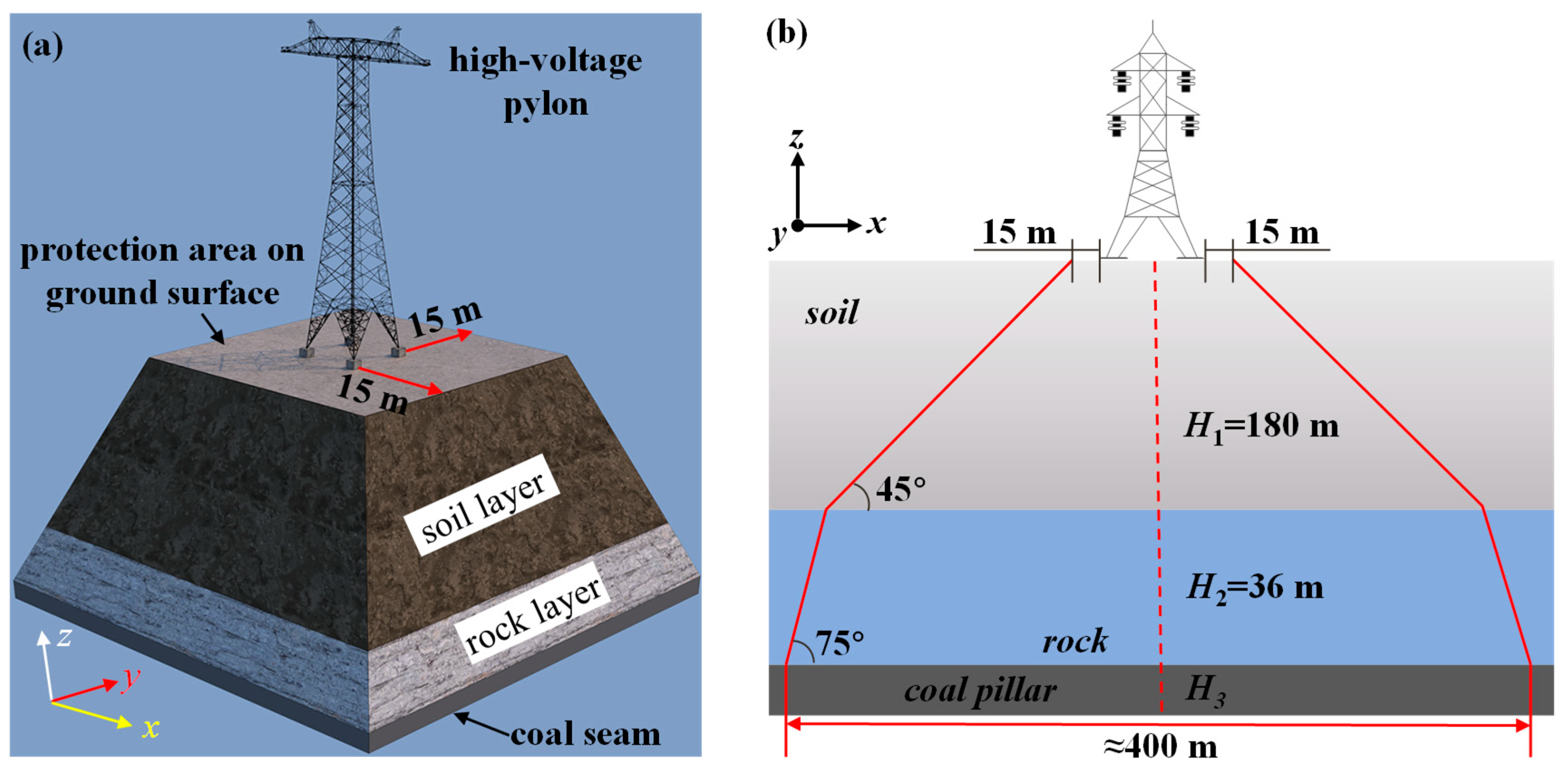

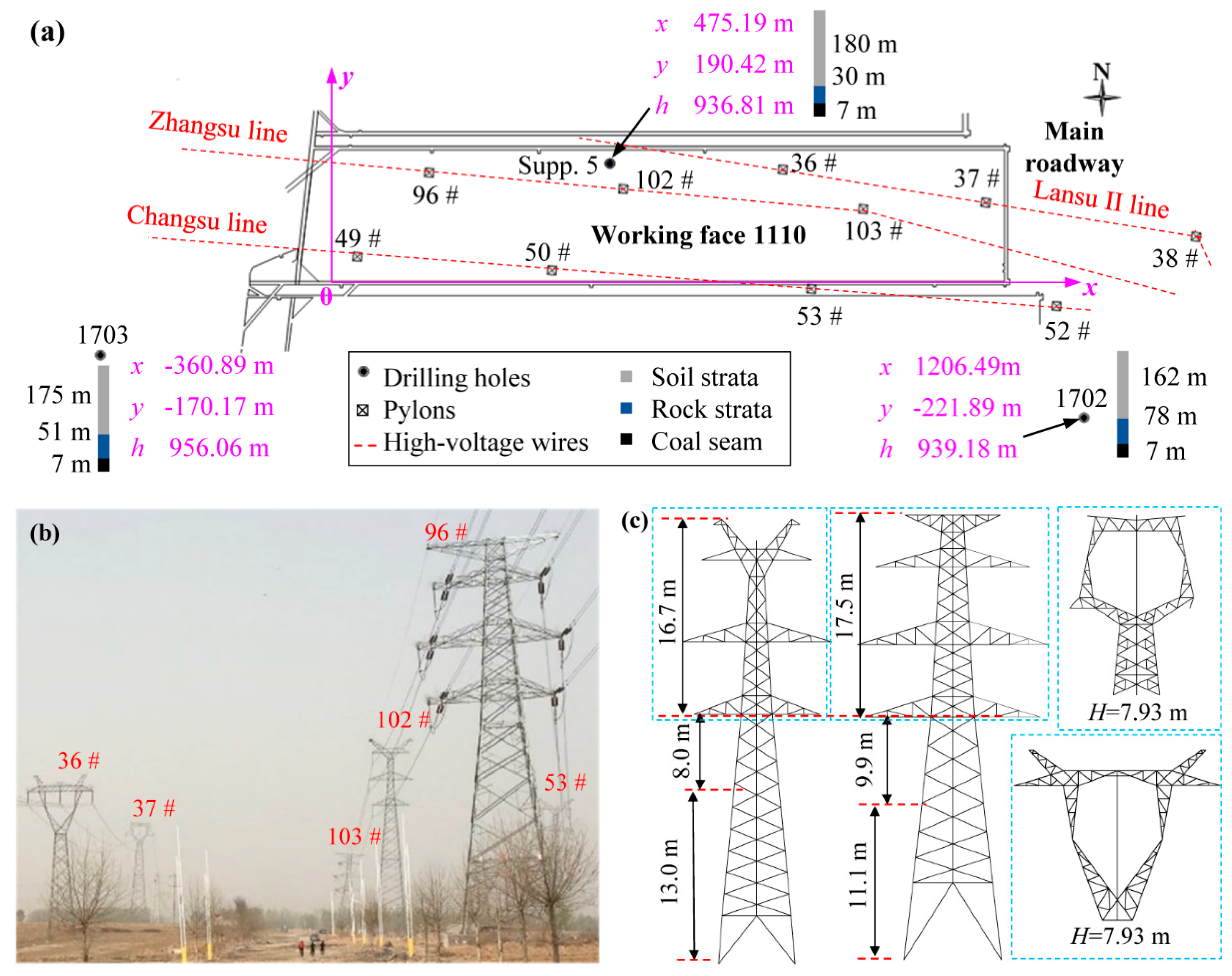
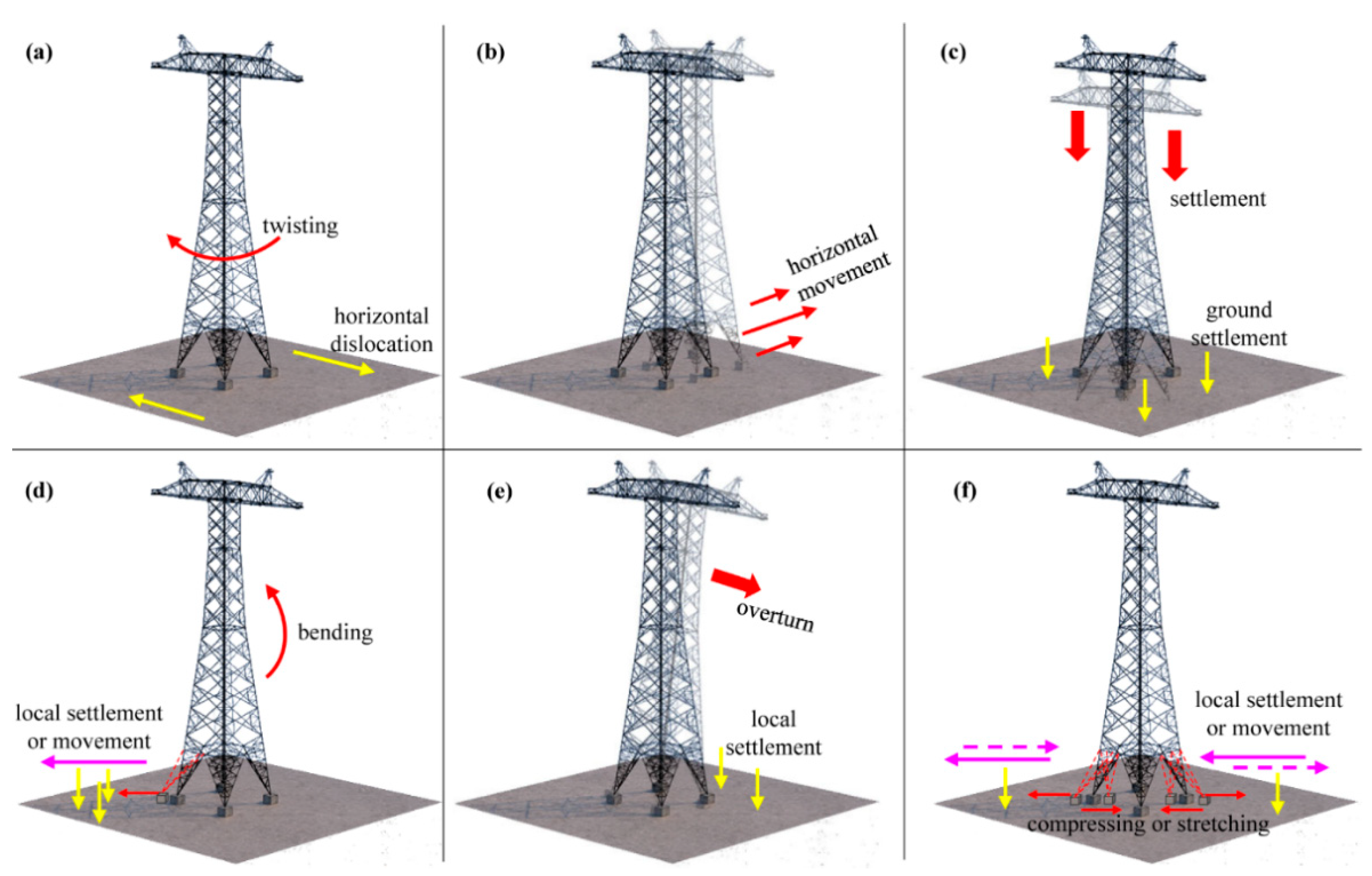
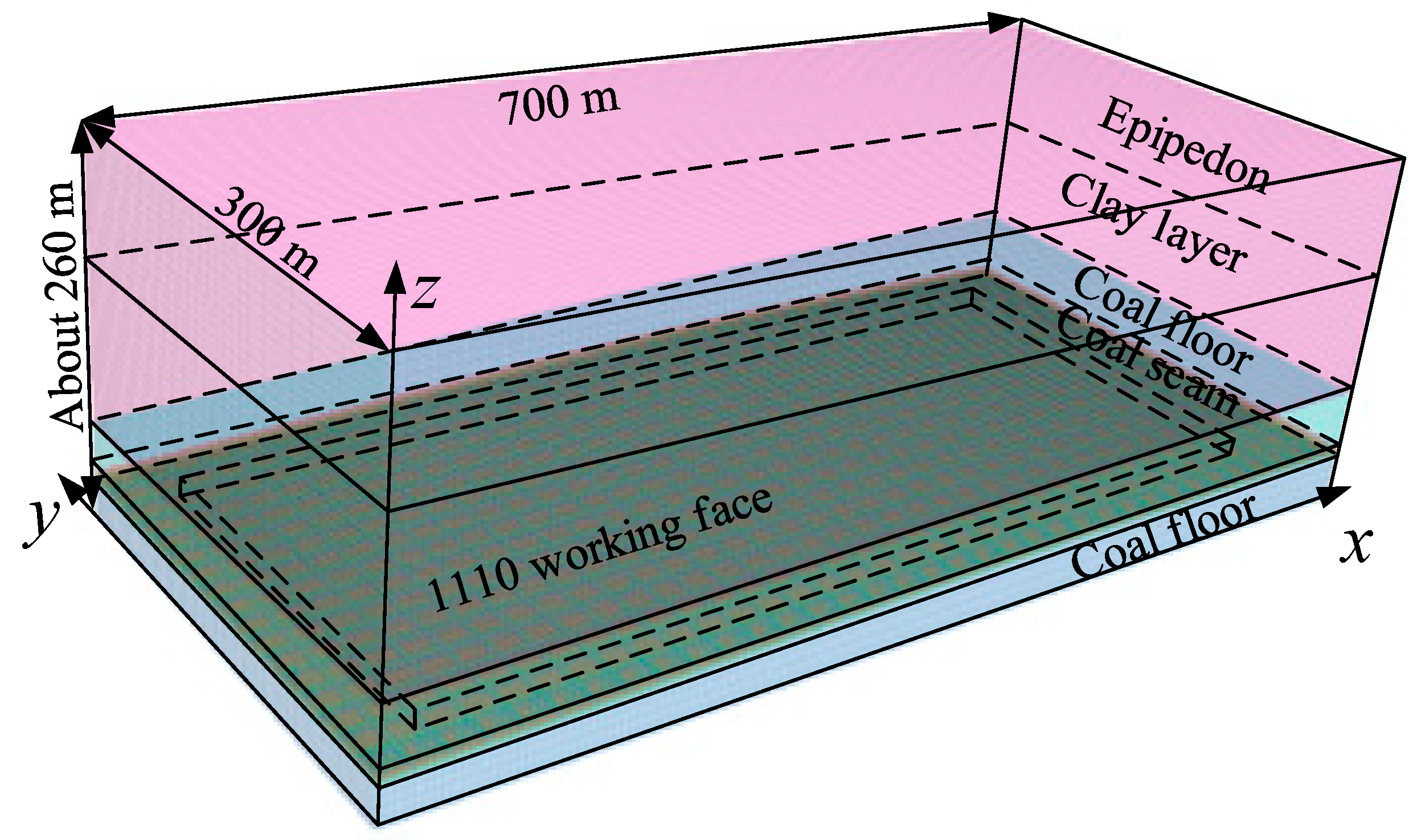


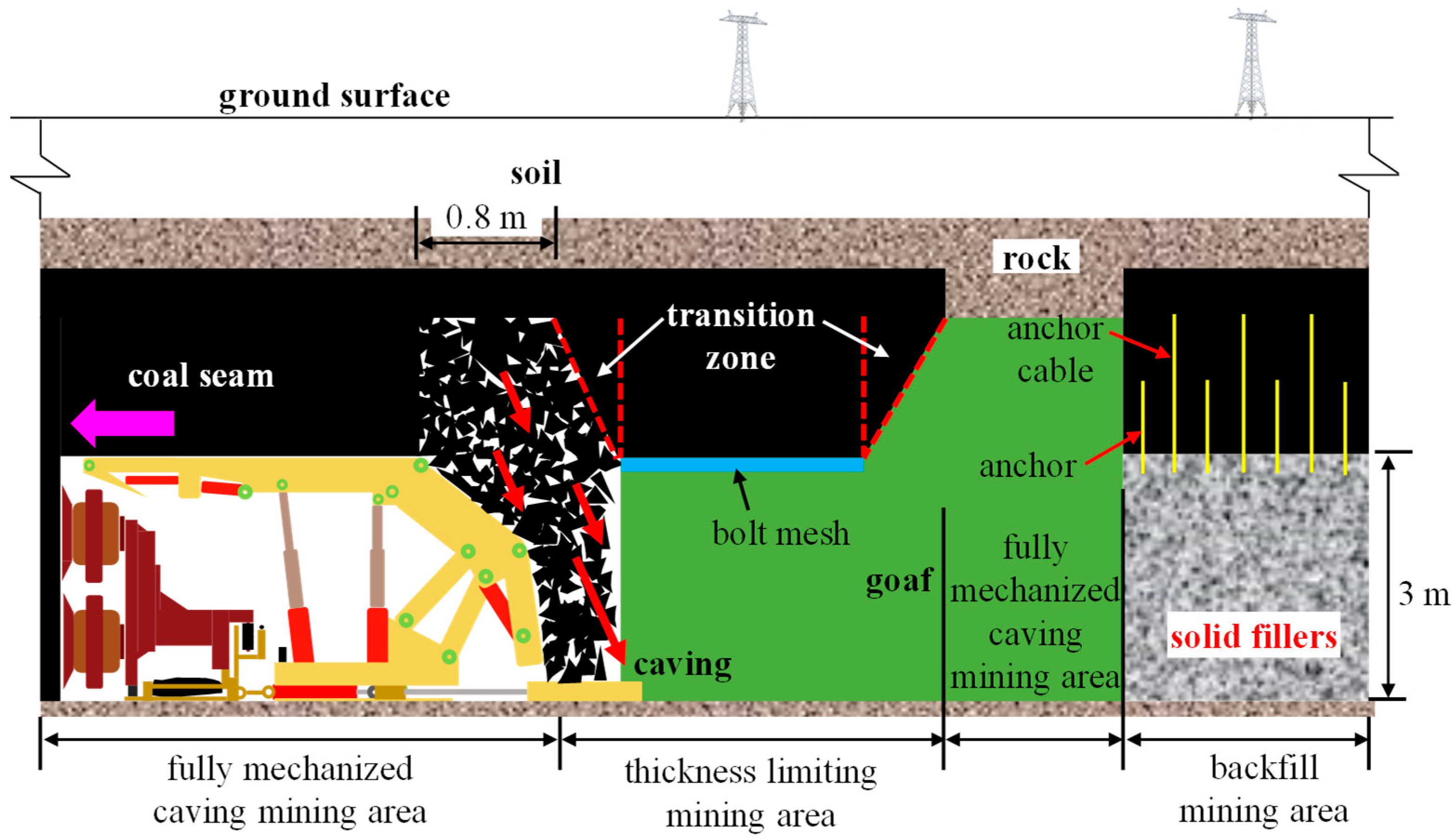
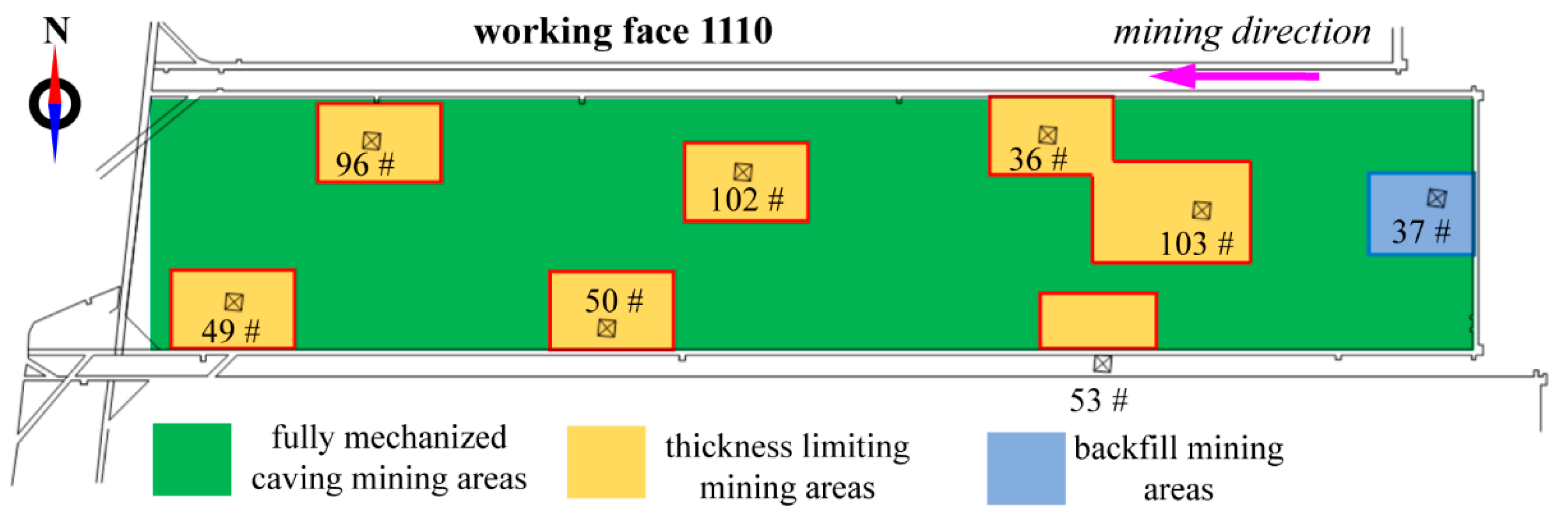
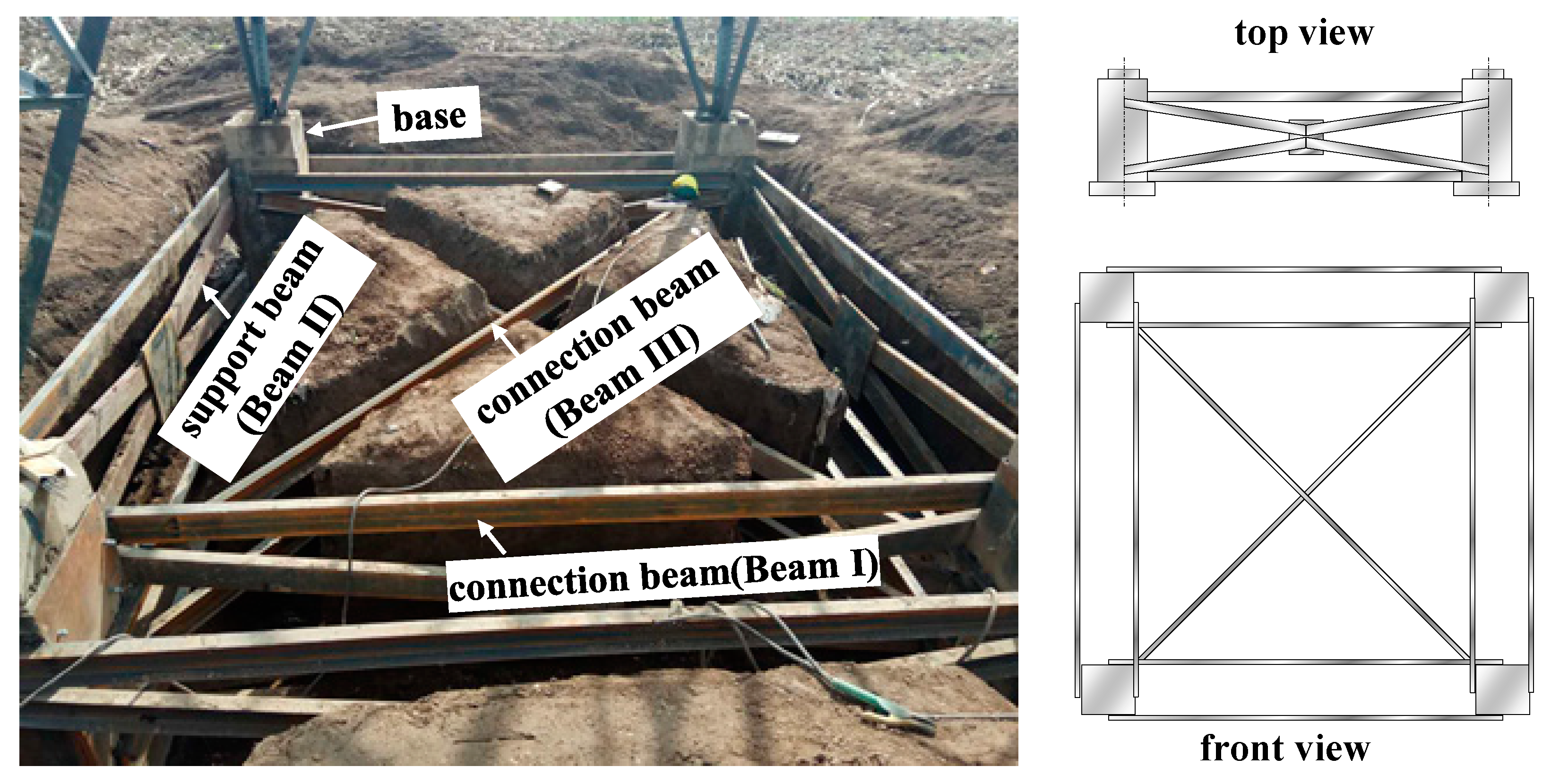
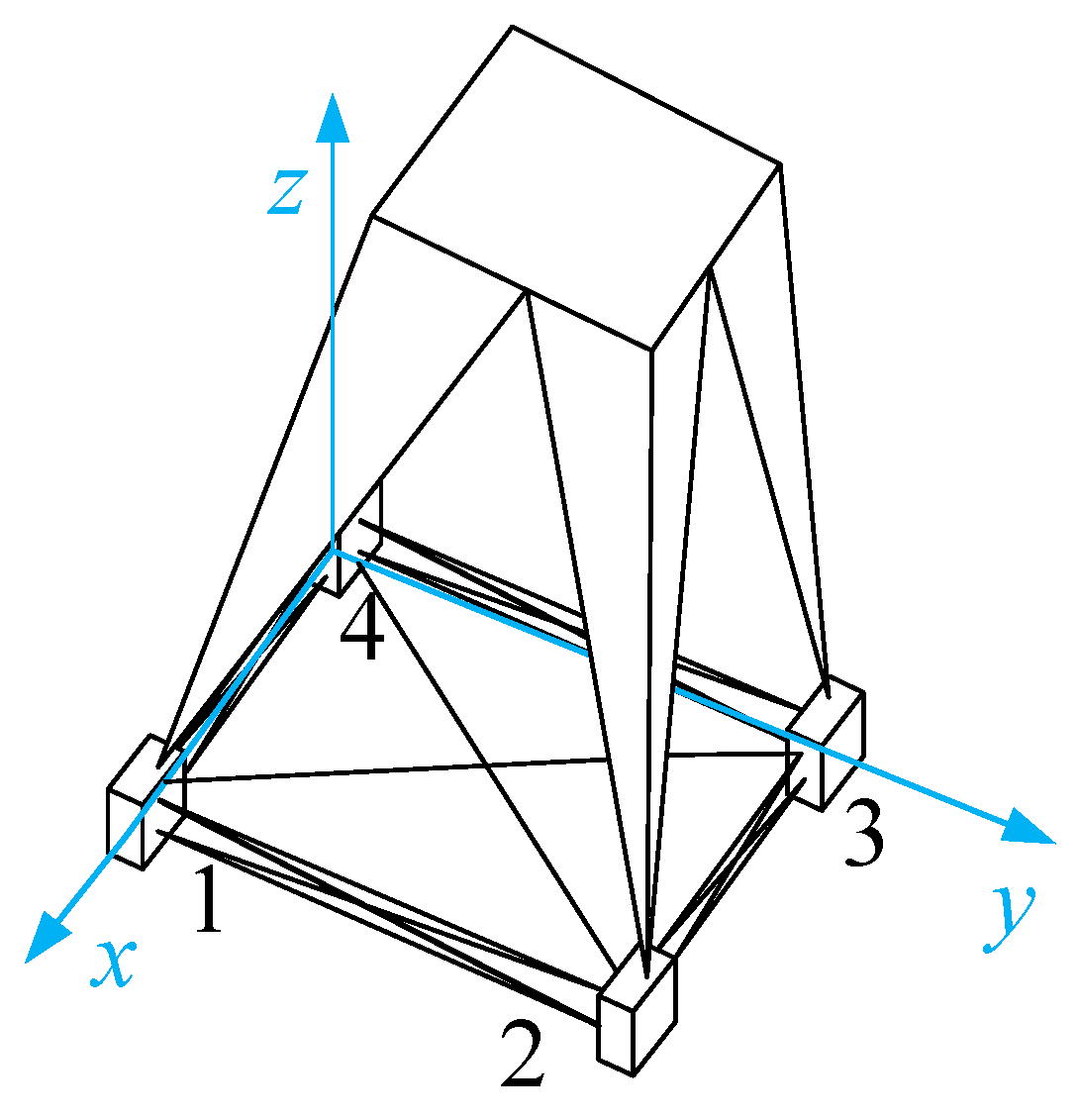

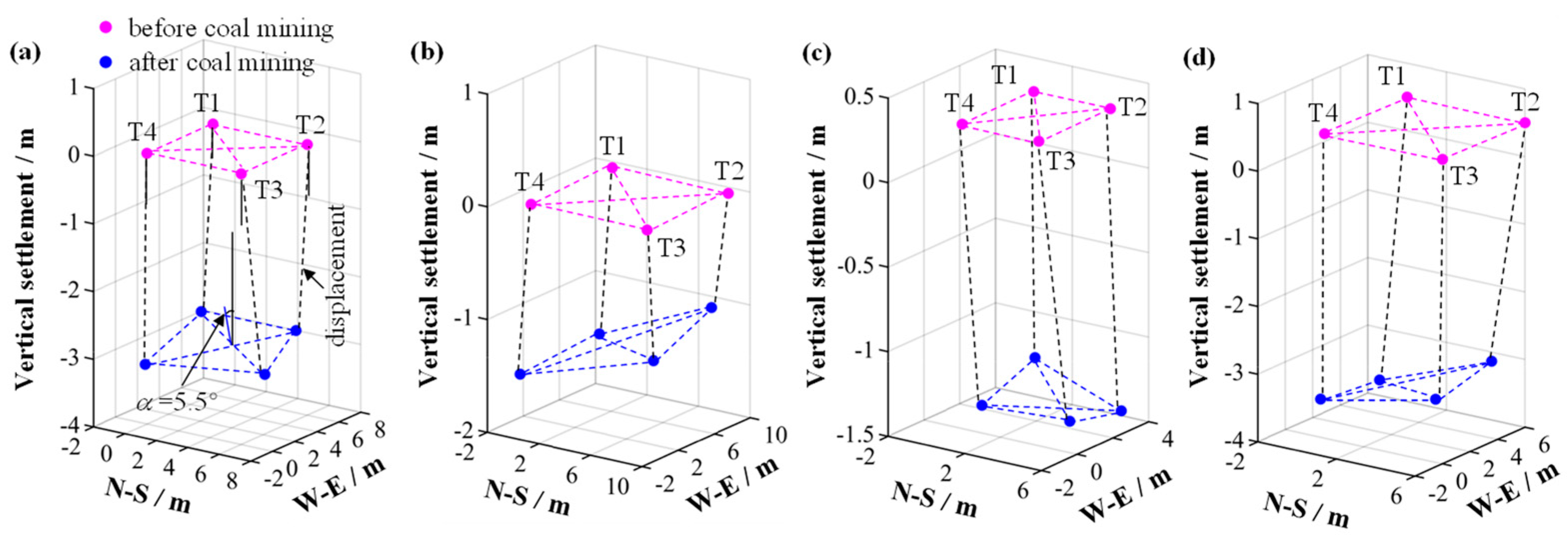

| Pylon No. | x/m | y/m | Pylon No. | x/m | y/m |
|---|---|---|---|---|---|
| 36# | 725 | 167 | 103# | 858 | 109 |
| 37# | 1054 | 123 | 49# | 26 | 38 |
| 96# | 173 | 172 | 50# | 370 | 13 |
| 102# | 478 | 144 | 53# | 771 | −15 |
| Rock/Soil Layer | Elasticity (Mpa) | Poisson’s Ratio | Cohesion (Mpa) | Internal Friction Angle (°) | Compressive Strength (Mpa) | Tensile Strength (Mpa) |
|---|---|---|---|---|---|---|
| Epipedon | 17.90 | 0.28 | 0.087 | 19.8 | -- | -- |
| Clay layer | 20.68 | 0.31 | 0.073 | 32.0 | 4.28 | 0.15 |
| Rock layer I | 2020 | 0.32 | 14.0 | 25.8 | 8.22 | 1.07 |
| Coal seam | 3100 | 0.33 | 2.6 | 32.0 | 18.6 | 0.20 |
| Rock layer II | 3750 | 0.20 | 10.0 | 36.2 | 29.9 | 2.0 |
| Key Regions | Plan 1 | Plan 2 | Plan 3 | Plan 4 | Plan 5 | |||||
|---|---|---|---|---|---|---|---|---|---|---|
| Length (m) | Width (m) | Length (m) | Width (m) | Length (m) | Width (m) | Length (m) | Width (m) | Length (m) | Width (m) | |
| 36# | 100 | 60 | 120 | 70 | 140 | 80 | 150 | 90 | 160 | 100 |
| 37# | 100 | 60 | 120 | 70 | 140 | 80 | 150 | 90 | 160 | 100 |
| 53# | 60 | 30 | 70 | 40 | 80 | 50 | 90 | 60 | 100 | 70 |
| 103# | 100 | 60 | 120 | 70 | 140 | 80 | 150 | 90 | 160 | 100 |
| Section Shape | Type of Beam | Type of Steel | Section Sizes (mm) | Theoretical Weight (kg/m) | ||
|---|---|---|---|---|---|---|
| h | b | d | ||||
 | Beam I | 16b | 160 | 65 | 8.5 | 19.74 |
| Beam II | 18b | 180 | 70 | 9 | 22.99 | |
| Beam III | 14b | 140 | 60 | 8 | 16.73 | |
| No. of Pylons | Vertical Settlement | Distance between Two Neighboring Bases | ||||||
|---|---|---|---|---|---|---|---|---|
| T1 | T2 | T3 | T4 | T1-T2 | T2-T3 | T3-T4 | T4-T1 | |
| 36# | 1.5 | 1.1 | 1.2 | 1.5 | 8.07 | 9.18 | 9.42 | 9.51 |
| 53# | 1.5 | 1.7 | 1.6 | 1.6 | 4.50 | 3.22 | 4.31 | 3.54 |
| 103# | 3.8 | 3.5 | 3.2 | 3.4 | 5.12 | 5.59 | 5.52 | 3.05 |
Publisher’s Note: MDPI stays neutral with regard to jurisdictional claims in published maps and institutional affiliations. |
© 2022 by the authors. Licensee MDPI, Basel, Switzerland. This article is an open access article distributed under the terms and conditions of the Creative Commons Attribution (CC BY) license (https://creativecommons.org/licenses/by/4.0/).
Share and Cite
Liu, H.; Du, M.; Zhang, B.; Lin, Z.; Liu, C.; Wang, F. Study on the Combined Mining Scheme for Coal Resources under High-Voltage Pylons and the Reinforcement for Pylons. Energies 2022, 15, 3978. https://doi.org/10.3390/en15113978
Liu H, Du M, Zhang B, Lin Z, Liu C, Wang F. Study on the Combined Mining Scheme for Coal Resources under High-Voltage Pylons and the Reinforcement for Pylons. Energies. 2022; 15(11):3978. https://doi.org/10.3390/en15113978
Chicago/Turabian StyleLiu, Hongyang, Mingrui Du, Boyang Zhang, Zhibin Lin, Chengwei Liu, and Feng Wang. 2022. "Study on the Combined Mining Scheme for Coal Resources under High-Voltage Pylons and the Reinforcement for Pylons" Energies 15, no. 11: 3978. https://doi.org/10.3390/en15113978
APA StyleLiu, H., Du, M., Zhang, B., Lin, Z., Liu, C., & Wang, F. (2022). Study on the Combined Mining Scheme for Coal Resources under High-Voltage Pylons and the Reinforcement for Pylons. Energies, 15(11), 3978. https://doi.org/10.3390/en15113978







